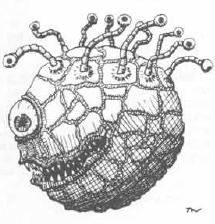This page is based on this
Wikipedia article Text is available under the
CC BY-SA 4.0 license; additional terms may apply.
Images, videos and audio are available under their respective licenses.

The beholder is a fictional monster in the Dungeons & Dragons fantasy role-playing game. Its appearance is that of a floating orb of flesh with a large mouth, single central eye, and many smaller eyestalks on top with powerful magical abilities.

Expedition to the Barrier Peaks is a 1980 adventure module for the Dungeons & Dragons role-playing game written by Gary Gygax. While Dungeons & Dragons (D&D) is typically a fantasy game, the adventure includes elements of science fiction, and thus belongs to the science fantasy genre. It takes place on a downed spaceship; the ship's crew has died of an unspecified disease, but functioning robots and strange creatures still inhabit the ship. The player characters fight monsters and robots, and gather the futuristic weapons and colored access cards that are necessary for advancing the story.
In the Dungeons & Dragons fantasy role-playing game, celestials are a class of creatures and monsters known as outsiders who are of wholly good alignment.
In the Dungeons & Dragons fantasy role-playing game, an ooze is a type of creature. This category includes such monsters as slimes, jellies, deadly puddings, and similar mindless, amorphous blobs. They can be used by Dungeon Masters as enemies of the player characters.
In Dungeons & Dragons, Fey is a category of creatures. The fey deities are associated with the Seelie Court and the Unseelie Court. Titania is the general fey deity, with individual races like the Killmoulis who worship Caoimhin. Fey are usually humanoid in form and generally have supernatural abilities and a connection to nature. The Sylph is one creature which has a Fey appearance, but is officially recognized as an outsider creature type.
In the Dungeons & Dragons fantasy role-playing game, creature types are rough categories of creatures which determine the way game mechanics affect the creature. In the 3rd edition and related games, there are between thirteen and seventeen creature types. Creature type is determined by the designer of a monster, based upon its nature or physical attributes. The choice of type is important, as all creatures which have a given type will share certain characteristics. In 3rd and 3.5 editions, type determines features such as hit dice, base attack bonus, saving throws, and skill points.
In the Dungeons & Dragons fantasy role-playing game, aberration is a creature type. Aberrations generally all have bizarre anatomies, strange abilities, alien mindsets, or any combination thereof.

In the Dungeons & Dragons fantasy role-playing game, an elemental is a type of creature. Elemental creatures are composed of one of the four classical elementals of air, earth, fire, or water.

The dragon turtle is a fictional creature from the Dungeons & Dragons role-playing game. The creature is depicted as a gigantic sea predator that breathes a cloud of scalding steam, and has an armored turtle-like shell and a dragon-like head. The dragon turtle was introduced in the original Dungeons & Dragons rule booklets in 1974 and subsequently appeared in the first edition Advanced Dungeons & Dragons game, and in the game's second edition and third edition.
This is intended to be a comprehensive list of creatures that have appeared in various Dungeons & Dragons works. Each individual list covers a span of years by edition of the game, with monsters being listed chronologically by book in which they appeared.
The Dungeons & Dragons fantasy role-playing game contains many monsters that are similar or related to dragons but which are not "true dragons", which are dragons that grow stronger with age. These can be magical beasts, half-dragons, creatures with more distant dragon ancestry, races descending from actual dragons, or creatures of other types, which resemble dragons. Alternatively, they could have the dragon type or keyword, but not be true dragons, or they could have the "dragonblood" subtype in the 3rd edition of Dungeons & Dragons.
In the Dungeons & Dragons fantasy role-playing game, Deathless was a classification of monsters that could be encountered by player characters. Deathless are creatures that have prolonged their lives unnaturally using magic.
This is the Index of Advanced Dungeons & Dragons 1st edition monsters, an important element of that role-playing game. This list only includes monsters from official Advanced Dungeons & Dragons 1st Edition supplements published by TSR, Inc. or Wizards of the Coast, not licensed or unlicensed third party products such as video games or unlicensed Advanced Dungeons & Dragons 2nd Edition manuals.
Monsters are an important element of the Dungeons & Dragons fantasy role-playing game. Since the game's first edition in 1974, a bestiary was included along other game manuals, first called Monsters & Treasure and now commonly called the Monster Manual. Described as an "essential" part of Dungeons & Dragons, the game's monsters have become notable in their own right, influencing fields such as video games and fiction, as well as popular culture.


